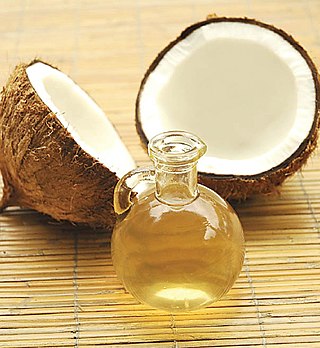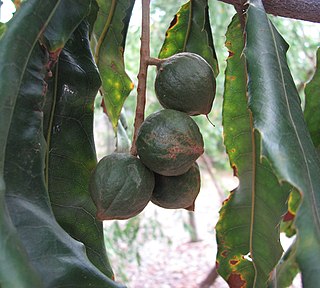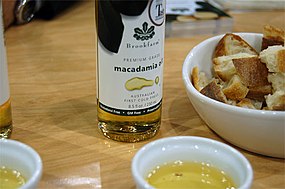
A triglyceride is an ester derived from glycerol and three fatty acids. Triglycerides are the main constituents of body fat in humans and other vertebrates, as well as vegetable fat. They are also present in the blood to enable the bidirectional transference of adipose fat and blood glucose from the liver, and are a major component of human skin oils.

A sunflower seed is a seed from a sunflower. There are three types of commonly used sunflower seeds: linoleic, high oleic, and sunflower oil seeds. Each variety has its own unique levels of monounsaturated, saturated, and polyunsaturated fats. The information in this article refers mainly to the linoleic variety.

Cashew is the common name of a tropical evergreen tree Anacardium occidentale, in the family Anacardiaceae. It is native to South America and is the source of the cashew nut and the cashew apple, an accessory fruit. The tree can grow as tall as 14 metres, but the dwarf cultivars, growing up to 6 m (20 ft), prove more profitable, with earlier maturity and greater yields. The cashew nut is edible and is eaten on its own as a snack, used in recipes, or processed into cashew cheese or cashew butter. The nut is often simply called a 'cashew'. Cashew can cause allergies triggered by the proteins found in the nuts.

Vegetable oils, or vegetable fats, are oils extracted from seeds or from other parts of fruits. Like animal fats, vegetable fats are mixtures of triglycerides. Soybean oil, grape seed oil, and cocoa butter are examples of seed oils, or fats from seeds. Olive oil, palm oil, and rice bran oil are examples of fats from other parts of fruits. In common usage, vegetable oil may refer exclusively to vegetable fats which are liquid at room temperature. Vegetable oils are usually edible.

Coconut oil is an edible oil derived from the kernels, meat, and milk of the coconut palm fruit. Coconut oil is a white solid fat below around 25 °C (77 °F), and a clear thin liquid oil in warmer climates. Unrefined varieties have a distinct coconut aroma. Coconut oil is used as a food oil, and in industrial applications for cosmetics and detergent production. The oil is rich in medium-chain fatty acids.

A nut is a fruit consisting of a hard or tough nutshell protecting a kernel which is usually edible. In general usage and in a culinary sense, a wide variety of dry seeds are called nuts, but in a botanical context "nut" implies that the shell does not open to release the seed (indehiscent).

Macadamia is a genus of four species of trees in the flowering plant family Proteaceae. They are indigenous to Australia, native to northeastern New South Wales and central and southeastern Queensland specifically. Two species of the genus are commercially important for their fruit, the macadamia nut. Global production in 2015 was 160,000 tonnes. Other names include Queensland nut, bush nut, maroochi nut, bauple nut and, in the US, they are also known as Hawaii nut. It was an important source of bushfood for the Aboriginal peoples.

Shea butter is a fat extracted from the nut of the African shea tree. It is ivory in color when raw and commonly dyed yellow with borututu root or palm oil. It is widely used in cosmetics as a moisturizer, salve or lotion. It is edible and is used in food preparation in some African countries. It is occasionally mixed with other oils as a substitute for cocoa butter, although the taste is noticeably different.

Mink oil is an oil used in medical and cosmetic products. It is obtained by the rendering of mink fat which has been removed from pelts bound for the fur industry.
The smoke point, also referred to as the burning point, is the temperature at which an oil or fat begins to produce a continuous bluish smoke that becomes clearly visible, dependent upon specific and defined conditions. Smoke point values can vary greatly, depending on factors such as the volume of oil utilized, the size of the container, the presence of air currents, the type and source of light as well as the quality of the oil and its acidity content, otherwise known as free fatty acid (FFA) content. The more FFA an oil contains, the quicker it will break down and start smoking. The lower the value of FFA, the higher the smoke point. However, the FFA content typically represents less than 1% of the total oil and consequently renders smoke point a poor indicator of the capacity of a fat or oil to withstand heat.

A nut butter is a spreadable foodstuff made by grinding nuts into a paste. The result has a high fat content and can be spread like true butter, but is otherwise unrelated. Nut butters include:

Canarium ovatum, the pili, is a species of tropical tree belonging to the genus Canarium. It is one of approximately 600 species in the family Burseraceae. C. ovatum are native to the Philippines. They are commercially cultivated in the Philippines for their edible nuts and is believed to be indigenous to that country. The fruit and tree are often vulgarized with the umbrella term of "Java almond" which mixes multiple species of the same genus, Canarium.

Pecan oil is an edible pressed oil extracted from the pecan nut. Pecan oil is neutral in flavor and takes on the flavor of whatever seasoning is being used with it. Pecan oil contains 9.5% saturated fat, which is less than in olive oil (13.5%), peanut oil (16.90%) or corn oil (12.70%). It is also used as a massage oil and in aromatherapy applications.

Macadamia tetraphylla is a tree in the family Proteaceae, native to southern Queensland and northern New South Wales in Australia. Common names include macadamia nut, bauple nut, prickly macadamia, Queensland nut, rough-shelled bush nut and rough-shelled Queensland nut.
Omega-7 fatty acids are a class of unsaturated fatty acids in which the site of unsaturation is seven carbon atoms from the end of the carbon chain. The two most common omega-7 fatty acids in nature are palmitoleic acid and vaccenic acid. They are widely used in cosmetics due to their moisturizing properties. Omega-7 fats are not essential fatty acids in humans as they can be made endogenously. Diets rich in omega-7 fatty acids have been shown to have beneficial health effects, such as increasing levels of HDL cholesterol and lowering levels of LDL cholesterol.

The H2 Hinde Tree is a heritage-listed tree of the species Macadamia integrifolia at Colliston, 926 Gilston Road, Gilston, City of Gold Coast, Queensland, Australia. It was added to the Queensland Heritage Register on 14 August 2008.

Cooking oil is a plant or animal liquid fat used in frying, baking, and other types of cooking. Oil allows higher cooking temperatures than water, making cooking faster and more flavorful, while likewise distributing heat, reducing burning and uneven cooking. It sometimes imparts its own flavor. Cooking oil is also used in food preparation and flavoring not involving heat, such as salad dressings and bread dips.

Canarium indicum, known as galip nut, is a mainly dioecious tree native in eastern Melanesia. It is usually found in rainforests, secondary forests, old garden areas, around villages and settlements. It is also used as a shade tree, as a windbreak and in agroforestry. Canarium is important in the world food system as it can be used as a food and timber source, in traditional medicine, intercropping and agroforestry.
















